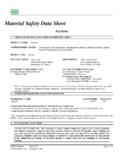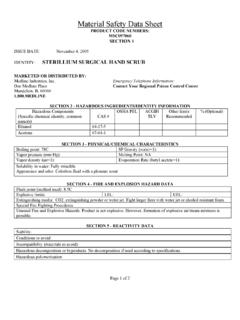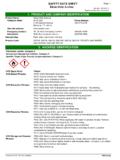Transcription of Safety Data Sheet - BRITE PRODUCTS
1 Safety data Sheet BRITE Zinc SECTION 1: IDENTIFICATION OF THE SUBSTANCE/MIXTURE AND THE COMPANY/UNDERTAKING Product Identifier Trade Name BRITE Zinc Product Number B-100 Relevant Identified Uses of the Substance or Mixture and Uses Advised Against Product Use: Welding Process Aid Details of the Supplier of the Safety data Sheet Manufacturer: Weld-Aid PRODUCTS 14650 Dequindre Detroit , Michigan Information Phone Number: +1 (313) 883-6977 +1 (313) 883-4930 E-mail Emergency Telephone Number Emergency Spill Information +1 (800) 255-3924 SDS Date of Preparation: August 29, 2014 SECTION 2: HAZARDS IDENTIFICATION Classification of the Substance or Mixture CLP/GHS Classification (1272/2008): Physical: Health: Environmental Flammable Aerosol Category 1 Gases Under Pressure Compressed Gas Aspiration Toxicity Category 1 Reproductive Toxicity Category 2 Specific Target Organ Toxicity Repeat Exposure Category 2 Eye Irritation Category 2A Specific Target Organ Toxicity Single Exposure 3 Aquatic Acute Category 2 Aquatic Chronic Category 2 EU Classification (67/548/EEC): Extremely Flammable (F+), Harmful (Xn), Irritant (Xi), Dangerous for the Environment (N) (Repr Cat 3), R12, R63, R36, R65, R66, R67, R51/53 Label Elements DANGER!
2 Contains acetone, methyl ethyl ketone, toluene Hazard Phrases H222 Extremely flammable aerosol. H280 Contains gas under pressure; may explode if heated. H304 May be fatal if swallowed and enters airways. H319 Causes serious eye irritation. H336 May cause drowsiness or dizziness. H361 Suspected of damaging fertility or the unborn child. H373 May cause damage to kidneys, liver, nervous system and hearing through prolonged or repeated exposure. H411 Toxic to aquatic life with long lasting effects. Safety data Sheet BRITE Zinc 2/9 Precautionary Phrases P201 Obtain special instructions before use. P202 Do not handle until all Safety precautions have been read and understood. P210 Keep away from heat, sparks, open flames and hot surfaces.
3 No smoking. P211 Do not spray on an open flame or other ignition source. P251 Pressurized container: Do not pierce or burn, even after use. P260 Do not breathe mist, vapors and spray. P264 Wash thoroughly after handling. P271 Use only outdoors or in a well-ventilated area. P273 Avoid release to the environment. P280 Wear protective gloves, protective clothing, eye protection or face protection. P301 + P310 IF SWALLOWED: Immediately call a POISON CENTER or doctor. P331 Do NOT induce vomiting. P304 + P340 IF INHALED: Remove to fresh air and keep at rest in a position comfortable for breathing. P312 Call a POISON CENTER or doctor if you feel unwell. P305 + P351 + P338 IF IN EYES: Rinse cautiously with water for several minutes. Remove contact lenses, if present and easy to do.
4 Continue rinsing. P337 + P313 If eye irritation persists: Get medical attention. P308 + P313 IF exposed or concerned: Get medical attention. P391 Collect spillage. P403 + P233 Store in a well-ventilated place. Keep container tightly closed. P405 Store locked up. P410 + P412 Protect from sunlight. Do not expose to temperatures exceeding 50 C/122 F. P501 Dispose of contents and container in accordance with local and national regulations. Other Hazards: None SECTION 3: COMPOSITION/INFORMATION ON INGREDIENTS Mixture: Chemical Name CAS# EINECS# EU Classification (67/548/EEC) GHS Classification Regulation (EC) No 1272/2008 % Propane/Butane Propellant 106-97-8 74-98-6 203-448-7 200-827-9 F+ R12 Flammable Gas Category 1 (H220) 10-30 Zinc 7440-66-6 231-175-3 N R50/53 Aquatic Acute Category 1 (H400) Aquatic Chronic Category 1 (H410) 10-20 VM&P Naphtha 8032-32-4 232-453-7 F, Xn R11, R65 Flammable Liquid Category 2 (H226), Aspiration Toxicity Category 1 (H304) 10-20 Acetone 67-64-1 200-662-2 F, Xi R11, R36, R66, R67 Flammable Liquid Category 2 (H226), Eye Irritation Category 2A (H319) Specific Target Organ Toxicity Single Exposure 3 (H336) 10-20 Methyl Ethyl Ketone 78-93-3 201-159-0 F, Xi R11, R36, R66, R67 Flammable Liquid Category 2 (H226)
5 , Eye Irritation Category 2A (H319), Specific Target Organ Toxicity Single Exposure 3 (H336) 10-20 Toluene 108-88-3 203-625-9 F, Xi, Xn (Repr Cat. 3) R11, R38, R48/20, R63, R65, R67 Flammable Liquid Category 2 (H226), Reproductive Toxicity Category 2 (H361), Aspiration Toxicity Category 1 (304) Specific Target Organ Toxicity Repeat Exposure Category 2 (H373) Skin Irritation Category 2 (H315), Specific Target Organ Toxicity Single Exposure 3 (H336) 1-<10 Stoddard Solvent 8052-41-3 232-489-3 Xn R10, R65 Aspiration Toxicity Category 1 (H304) Flammable Liquid 3 (H226) <5 Aluminum 7429-90-5 231-072-3 Not dangerous Not hazardous <5 Safety data Sheet BRITE Zinc 3/9 Aliphatic Petroleum Distillates 64742-89-8 265-192-2 F, Xn R11, R65 Aspiration Toxicity Category 1 (H304) Flammable Liquid 3 (H226) <5 See Section 16 for further information on EU and GHS Classification.
6 SECTION 4: FIRST AID MEASURES Description of First Aid Measures Eyes: Flush eyes immediately with water for several minutes, holding the eyelids apart. If irritation persists, call a physician. Skin: Remove contaminated clothing and shoes. Wash exposed area thoroughly with soap and water. Wash contaminated clothing before reuse. Get medical attention if irritation develops or persists. Inhalation: Remove to fresh air. If breathing is difficult have qualified personnel administer oxygen. If breathing has stopped, administer artificial respiration. Get medical attention. Ingestion: Ingestion is an unlikely route of exposure for aerosol PRODUCTS . If ingestion occurs rinse mouth with a small amount of water. Aspiration hazard DO NOT Induce Vomiting.
7 Never give anything by mouth to an unconscious or drowsy person. Get immediate medical attention. Most Important symptoms and effects, both acute and delayed: May cause eye and skin irritation. Inhalation of vapors or mist may cause respiratory irritation and central nervous system effects such as headache, dizziness, drowsiness, nausea and unconsciousness. Aspiration Hazard - harmful or fatal if swallowed. Overexposure may cause adverse effects to the liver, kidney, nervous system and hearing. May cause adverse reproductive effects based on animal data . Indication of any immediate medical attention and special treatment needed: Immediate medical treatment is required for ingestion. SECTION 5: FIRE FIGHTING MEASURES Extinguishing Media: Use carbon dioxide, dry chemical or foam to extinguish fire.
8 Cool fire exposed containers with water. Special Hazards Arising from the Substance or Mixture Unusual Fire and Explosion Hazards: Contents under pressure. Extremely flammable aerosol. Exposure of containers to extreme heat and flames can cause them to rupture often with violent force. Vapors are heavier than air and may and accumulate in low lying area. Combustion PRODUCTS are toxic. Hazardous Decomposition PRODUCTS : Combustion may produce carbon monoxide, carbon dioxide, zinc oxide and other organic materials. Advice for Fire-Fighters: Firefighters should always wear self-contained breathing apparatus and full protective clothing for fires involving chemicals or in confined spaces. Do not allow run-off from fire fighting to enter drains or water courses.
9 Use shielding to protect against bursting containers. SECTION 6: ACCIDENTAL RELEASE MEASURES Personal Precautions, Protective Equipment and Emergency Procedures: Evacuate spill area and keep unprotected personnel away. Eliminate all ignition sources. Ventilate area. Wear appropriate protective clothing as described in Section 8. Environmental Precautions: Avoid contamination of soil, surface water and ground water. Do not flush to sewer! Report releases as required by local, state and federal authorities. Methods and Material for Containment and Cleaning Up: Contain and collect using an absorbent material and place in an appropriate container for disposal. Leaking cans should be placed in a plastic bag or open pail until the pressure has dissipated.
10 Safety data Sheet BRITE Zinc 4/9 Reference to Other Sections: Refer to Section 8 for protective equipment and Section 15 for disposal considerations. SECTION 7: HANDLING AND STORAGE Precautions for Safe Handling: Avoid contact with the eyes, skin and clothing. Avoid breathing vapors. Do not swallow. Wear protective clothing and equipment as described in Section 8. Use only with adequate ventilation. Do not use in poorly ventilated or confined spaces. Vapors are heavier than air and will collect in low areas. Wash thoroughly with soap and water after handling and before eating, drinking or using restroom. Contents under pressure. Do not puncture or incinerate container. Do not eat, drink or smoke in work areas. Do not cut, drill, grind or weld on or near containers, even empty containers.




